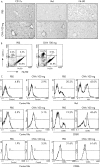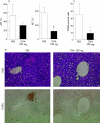Periportal and sinusoidal liver dendritic cells suppressing T helper type 1-mediated hepatitis
- PMID: 17872571
- PMCID: PMC2000248
- DOI: 10.1136/gut.2007.121251
Periportal and sinusoidal liver dendritic cells suppressing T helper type 1-mediated hepatitis
Abstract
Background: Recently, we found that portal vein tolerance is associated with generation of Th2 cells and apoptosis of Th1 cells in the liver, which is regulated by antigen (Ag)-presenting dendritic cells (DCs) in the periportal area and sinusoids.
Aim: In this study, we tested whether the periportal and sinusoidal DCs, which were loaded with an Ag in vivo, can inhibit liver injury caused by Th1 cells activated by the Ag administered systemically.
Methods: Ag-specific hepatitis model was created by adoptively transferring ovalbumin (OVA)-specific CD4(+) T cells to BALB/c mice and venous injection of OVA-containing liposomes. Liver CD11c(+) cells obtained from mice fed OVA were then transferred into these mice.
Results: The transfer of liver CD11c(+) cells from OVA-fed mice completely inhibited hepatic injury, which was associated with apoptosis of OVA-specific CD4(+) T cells and emergence of Th2 cells in the liver. Transfer of CD11c(+) cells and subcutaneous OVA challenge led to enhancement of OVA-specific IgE Ab as well as Th2 cytokine responses in the recipient mice.
Conclusions: Periportal and sinusoidal DCs loaded with an Ag in the portal vein can induce Th2 response in the liver and prevent hepatic injury caused by Th1 cells.
Conflict of interest statement
Competing interests: None.
Similar articles
-
A liver tolerates a portal antigen by generating CD11c+ cells, which select Fas ligand+ Th2 cells via apoptosis.Hepatology. 2003 Aug;38(2):403-12. doi: 10.1053/jhep.2003.50343. Hepatology. 2003. PMID: 12883484
-
Persistence of apoptosis-resistant T cell-activating dendritic cells promotes T helper type-2 response and IgE antibody production.Mol Immunol. 2008 Apr;45(8):2177-86. doi: 10.1016/j.molimm.2007.12.004. Epub 2008 Jan 31. Mol Immunol. 2008. PMID: 18237782
-
Splenic dendritic cells induced by oral antigen administration are important for the transfer of oral tolerance in an experimental model of asthma.J Immunol. 2006 Feb 1;176(3):1481-9. doi: 10.4049/jimmunol.176.3.1481. J Immunol. 2006. PMID: 16424176
-
Neighborhood politics: the immunoregulatory function of organ-resident liver endothelial cells.Trends Immunol. 2001 Aug;22(8):432-7. doi: 10.1016/s1471-4906(01)01957-3. Trends Immunol. 2001. PMID: 11473832 Review.
-
[Autoimmune hepatitis in the sight of contemporary immunology].Pol Arch Med Wewn. 2002 Jun;107(6):567-73. Pol Arch Med Wewn. 2002. PMID: 12371390 Review. Polish. No abstract available.
Cited by
-
Host-microbe interactions and defense mechanisms in the development of amoebic liver abscesses.Clin Microbiol Rev. 2009 Jan;22(1):65-75, Table of Contents. doi: 10.1128/CMR.00029-08. Clin Microbiol Rev. 2009. PMID: 19136434 Free PMC article. Review.
-
Dendritic Cell-Mediated Regulation of Liver Ischemia-Reperfusion Injury and Liver Transplant Rejection.Front Immunol. 2021 Jun 28;12:705465. doi: 10.3389/fimmu.2021.705465. eCollection 2021. Front Immunol. 2021. PMID: 34262574 Free PMC article. Review.
-
Hepatic stroma-educated regulatory DCs suppress CD8+ T cell proliferation in mice.Oncotarget. 2017 Jun 13;8(55):93414-93425. doi: 10.18632/oncotarget.18459. eCollection 2017 Nov 7. Oncotarget. 2017. PMID: 29212160 Free PMC article.
-
Immunostimulatory properties of dendritic cells after Leishmania donovani infection using an in vitro model of liver microenvironment.PLoS Negl Trop Dis. 2010 Jun 8;4(6):e703. doi: 10.1371/journal.pntd.0000703. PLoS Negl Trop Dis. 2010. PMID: 20544029 Free PMC article.
-
DAP12 promotes IRAK-M expression and IL-10 production by liver myeloid dendritic cells and restrains their T cell allostimulatory ability.J Immunol. 2011 Feb 15;186(4):1970-80. doi: 10.4049/jimmunol.1000527. Epub 2011 Jan 21. J Immunol. 2011. PMID: 21257958 Free PMC article.
References
-
- Crispe I N. Hepatic T cells and liver tolerance. Nat Rev Immunol 2003351–62. - PubMed
-
- Thomson A W, Lu L. Are dendritic cells the key to liver transplant tolerance? Immunol Today 19992027–32. - PubMed
-
- Callery M P, Kamei T, Flye M W. The effect of portacaval shunt on delayed‐hypersensitivity responses following antigen feeding. J Surg Res 198946391–394. - PubMed
MeSH terms
Substances
LinkOut - more resources
Full Text Sources
Research Materials





